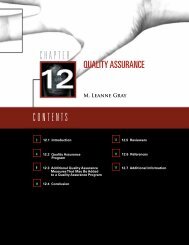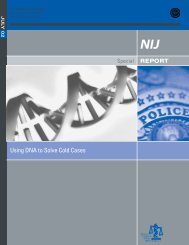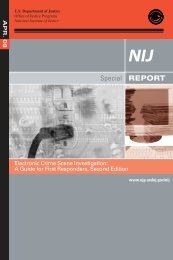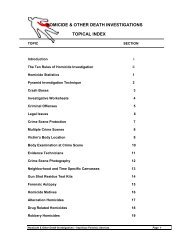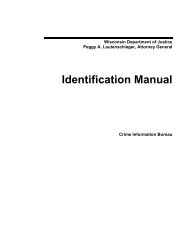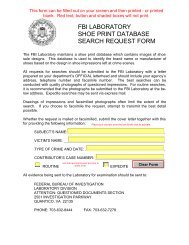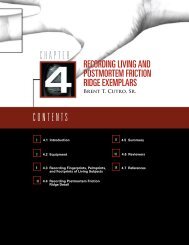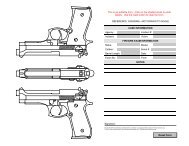THE NINHYDRIN REACTION WITH AMINO-ACIDS AND ...
THE NINHYDRIN REACTION WITH AMINO-ACIDS AND ...
THE NINHYDRIN REACTION WITH AMINO-ACIDS AND ...
- No tags were found...
You also want an ePaper? Increase the reach of your titles
YUMPU automatically turns print PDFs into web optimized ePapers that Google loves.
V. J. Harding and F. H. S. Warneford 321NH-CONH-COI I I I ;:O “;”CO C (OH)2 --+CO CH-O-C (OH) COI I I I I INH-CO NH-CO CO-NHAlloxan.coCo&/C(OH)z -+ C&H4/\ co > \coAlloxantin.co >Triketohydrindene hydrate. Hydrindantin.On warming with a mixture of ammonium carbonate and ammoniumacetate these gave murexide and the ammonium salt ofdiketohydrindylidene-diketohydrindamine respectively.NH-COCO-NHI I I ICO C-N = C CObo-AH.,,,((:‘>-N = C “\C,H,
322 Ninhydrin Reaction1. The coloring matter gives a broad absorption band in thevisible spectrum when examined in dilute solution. This band extendsfrom the red into the green part of the spectrum, blockingout almost entirely the whole of the yellow.‘l2. The blue color changes to a purple when viewed in artificiallight, resembling very much the color of dilute potassium permanganatewhen viewed in daylight.3. The color is quantitatively resistant to oxidation by the passageof a rapid current of air.Prepared by either of the two methods-by the action of ammoniumcarbonate and acetate upon hydrindantin, or by the interactionof alanine and triketohydrindene hydrate-the coloringmatter shows the same characteristics in dilute solution. It isalso of interest to note that murexide gives a similar absorptionband,lz thus supporting the analogy drawn by Ruhemann.The Interaction of Ammonium Salts and Trilcetohydrindene Hydrate.It has just been stated that various contradictory results hadbeen obtained by the earlier observers on the positive or negativenature of the ninhydrin reaction with ammonium salts.This we believe has been due to the use of ammonium salts ofdifferent concentrations. In our experiments we have used thepure ammonium salts obtainable from Kahlbaum or Schuchardt.Where these were not available we have taken a known weight ofthe pure acid, and added the theoretical amount of ammoniafrom a standardized solution of ammonium hydroxide. In thisway we have made sure of the purity of our salts. The purityof the Kahlbaum or Schuchardt specimens was controlled by adetermination of their ammonia content by means of Nesslerization.The process of carrying out the ninhydrin reaction has beento take 1.0 cc. of ammonium salt and 1.0 cc. of 1 per cent ninhydrinsolution, and heat them for 20 minutes in a rapidly boilingwater bath.Downloaded from www.jbc.org by on March 14, 200911 We have found, since writing the preliminary report, that the existenceof this absorption band was first noticed by Deniges, G., Bull. Sot.Pharm. Bordeaux, 1914, liv, 49, of whose work we were unaware at the time.I* Compare Hartley, W. N., J. Chem. Sot., 1887, li, 153.
V. J. Harding and F. H. S. Warneford323The following table shows the results obtained :Salt.Chloride ...............Nitrate ................Sulfate .................Hydrogen phosphate ...Sodium hydrogen phosphate...............Formate ...............Acetate ................Carbonate. ............Succinate ..............Glycollate. ............Lactate ................Malate .................Tartrate ...............Citrate ................Oxalate ................Benzoate. ..............Thiocyanate. ..........c :oncentration.--per cent-1.01.01.01.01.00.920.281.01.01.00.80.21.01.01.01.01.0TABLE I.No reaction.‘I ““ ‘IReaction.Intense violet red; blue on dilution.“ ‘I “ “ I‘ ‘IDeep violet red.Violet.Intense violet red; blue on dilution.Deep reddish violet.Violet.‘I‘IReddish violet; blue on dilution.Violet.Deep reddish violet; blue on dilution.Violet.Deep reddish violet.A glance at the table will show that all the ammonium saltstested, with the exception of those of the strong mineral acids,give a positive ninhydrin reaction. By increasing the concentration,however, even the salts of these acids can be made to showa positive test. Thus in a concentration of 5 per cent, ammoniumsulfate gives a decided pinkish color. The chloride and the nitrate,however, require to be nearly saturated before responding,faintly but unmistakably, to the test, and it certainly seems significantthat the salts of the strongest acids require to be usedat the highest concentration before they show the ninhydrin reaction.Our own list contains seventeen ammonium salts: the twoof Neuberg’j contain nineteen other salts, including salts of manyrare thio-acids, and together they include almost every type ofacid, so that we feel justified in stating that the ninhydrin reactionis given by all ammonium salts, provided the concentrationbe sufficiently high. If, however, the concentration is very lowDownloaded from www.jbc.org by on March 14, 2009
324 Ninhydrin Reactiona negative reaction is obtained in all cases. Thus when the concentrationof the ammonium salt is such that 1.0 cc. = 0.05 mg.ammonium nitrogen, then, in all cases examined (twenty), withbut one exception, a perfectly colorless solution resulted on heatingthem with 1.0 per cent aqueous ninhydrin solution (TableII). The one exception is ammonium sodium hydrogen phosphate,which gives a very faint trace of violet color under thoseconditions and the probable cause of this exception will be discussedlater.In the majority of cases we have been able to identify the blueor violet coloration as due, at any rate in part, to the ammoniumsalt of diketohydrindylidene-diketohydrindamine.We used thethree tests mentioned on page 322, but in no case was sufficientcolor present to be determined quantitatively by the Harding-MacLean calorimetric method.1” The discrepancies of previousobservers can thus be accounted for; in concentration of about 1per cent the ammonium salts of the weak organic acids give anunmistakable ninhydrin reaction, which is not the case when theconcentration is extremely low (1.0 cc. = 0.05 mg. ammoniumnitrogen).In view of the results it became of interest and importance todetermine whether ammonium salts in very dilute solution gavea ninhydrin reaction in the presence of pyridine. This modificationof the ninhydrin reaction discovered by Harding and Mac-Lean13 results in a quantitative decomposition of the a-aminonitrogen of amino-acids. How far, if at all, does it affect the decompositionof ammonium nitrogen when in similar concentration?The method of investigation was as follows:Downloaded from www.jbc.org by on March 14, 2009Standard solutions of different ammonium salts were prepared of sucha strength that 1 cc. of solution contained 0.05 mg. of ammonium nitrogen,thus being equivalent in strength to the standard alanine.1 cc. of the ammonium salt solution together with 1 cc. of 10 per centaqueous pyridine and 1 cc. of 1 per cent ninhydrin were heated for a periodof 20 minutes in a rapidly boiling water bath. A strong blue color developed.The contents of the test-tube were cooled, diluted to 50 cc., andthe amount of color was measured against a standard alanine color simultaneouslyprepared.I3 Harding, V. J., and MacLean, R. M., J. Biol. Chem., 1915, xx, 217.
V. J. Harding and F. H. S. Warneford 325For reasons given in a previous paper14 the amount of decompositionof alanine, etc., is assumed to be quantitative. It will beseen by a glance at Table II that the decomposition of ammoniumnitrogen under these conditions is constant and independent ofthe acid attacked, the two columns representing duplicate determinations.-TABLEAmmonium salt. Without pyridine.II.Withpyrldine.Nitrogendecomposed.Chloride ....................Nitrate .....................Sulfate .....................Sodium hydrogen phosphateHydrogen phosphate ........Carbonate ..................Formate ....................Acetate ....................Oxalate ....................Succinate ....................Glycollate ..................Lactate ....................Malate .....................Tartrate ....................Citrate .....................&Oxybutyrate ..............Benzoate. ..................Cinnamate .................Opianate ...................Thiocyanate ................3.-No“color.“‘I ‘IVery pale violet colaNo“color.“‘L I‘“ ““ “I‘ ‘0‘I ““ “‘I ““ “‘I ‘II‘ “‘I ‘I“ ‘I‘I “I‘ ‘Im&7.rn”.0.019 0.0200.018 0.0180.017 0.0160.016 0.0150.019 0.0190.018 0.0180.019 0.0190.020 0.0200.017 0.0180.020 0.0190.019 0.0190.019 0.0190.020 0.0190.018 0.0190.015 0.0150.020 0.0200.020 0.0220.020 0.0200.018 0.0180.019 0.019Downloaded from www.jbc.org by on March 14, 2009This decomposition of ammonium nitrogen is constant at about0.018 mg. in 0.05 mg., or about 36 per cent, and the identificationof the coloring matter as the ammonium salt of diketohydrindylidene-diketohydrindamineis readily effected by the use of thethree afore mentioned tests.We next investigated the effect of varying amounts of ninhydrinand pyridine upon the reaction under conditions which par-allel those in our studies on the decomposition of alanine. Thisis shown in Table III.I4 Harding and MacLean, J. Biol. Chem., 1916, xxiv, 503.
326 Ninhydrin ReactionAmmonium salt.1 cc. = 0.05 mg. N.Chloride .........“ .........‘I .........‘I .........“ .........‘I .........Sulfate ..........l‘ ..........“ ..........“ ..........I‘..........“ ..........Nitrate ..........Acetate .........Benzoate. .......-. .. .. . .. .. . ... .. .. .. .--. .. . .. .--5cc.11Pyridine--TABLEIII.concentration(per cent).cc.111111111cc.11--25cc.11Ninhydrinconcentration(per cent).cc.11112111122222cc.11m!?.0.0100.0170.0190.0200.0240.0250.0100.0180.0190.0200.0250.0260.0250.0250.0261 cc. of the ammonium salt was heated with the amount of pyridineand ninhydrin stated, in a boiling water bath for a periodof 20 minutes, and the amount of ammonium nitrogen decomposedwas found in the usual way. It will be seen that concentrationsof pyridine higher than IO per cent have very little influence,though there is to be noted a small but distinct rise. In thisrespect the reaction of an ammonium salt differs from that ofalanine. An increase in the amount of ninhydrin, even if theninhydrin be used in the same concentration, causes a markedincrease in coloring matter. With alanine, no such increase isnoted.We have not made any extensive studies on the influence oftime on this reaction. At the end of 20 minutes, however, thereaction is mainly complete. Thus an isolated observation onammonium fl-hydroxybutyrate showed that an hour’s heating at100°C. only increased the decomposition of the nitrogen from0.020 to 0.027 mg.In summing up the experimental results, it will be seen that allammonium salts under the right conditions are capable of givingDownloaded from www.jbc.org by on March 14, 2009
V. J. Harding and F. H. S. Warneford 327the ninhydrin reaction. Those conditions appear to be a faintalkalinity of solution, brought about either by the ammonium saltitself or by the presence of pyridine. The coloring matter formedagrees in properties with the ammonium salt of diketohydrindylidene-diketohydrindamineprepared either synthetically or by theinteraction of alanine and triketohydrindene hydrate, and therethus remains the task of showing how ammonium salts ingeneralcan interact with Ruhemann’s reagent and give an end-productidentical with that produced from amino-acids. The simplestand most obvious explanation, that amino-acids pass into ammoniumsalts, is inadequate, for if so, the decompositions shouldeither parallel one another or ammonium salts should be morereactive than amino-acids, statements which are not in agreementwith experimental facts. Of the two, amino-acids are byfar the more reactive. They react in much more dilute solutionsthan ammonium salts and, in the presence of pyridine, are nearlythree times as strong in their action.The Mechanism of the Ninhydrin Reaction.Ruhemann’s7 view of the interaction of amino-acids and triketohydrindenehydrate involves the oxidation of the amino-acid tocarbon dioxide and an aldehyde possessing a carbon atom less.than the amino-acid with the simultaneous reduction of the tri-,ketone to hydrindantin and the condensation of the hydrindantinwith the ammonia liberated by the oxidation of the amino-acid,forming the blue colored ammonium salt of diketohydrindylidene-diketohydrindamine.Such a mechanism, while satisfactoryfor amino-acids, does not explain the positive ninhydrin reactionwith ammonium salts, especially of inorganic acids. AdoptingRuhemann’s view of the constitution of the blue coloringmatter, we have sought to determine the mechanism wherebythe amino-acid acts as a reducing agent and to see whether anyparallel reaction was possible with an ammonium salt.In this respect we have utilized the theory of Dakin and Dudley,16who have postulated that amino-acids undergo either adissociation or a decomposition into ammonia and the correspondingglyoxal.Downloaded from www.jbc.org by on March 14, 2009I5 Dakin, H. D., and Dudley, H. W., J. Bid. Chem.. 1913. xv 127.
328 Ninhydrin ReactionRCHNHz . COOH + RCO . CHO + NHaTheir later work has inclined them to the belief that the reactionexpressed is not a true chemical dissociation. In the case ofalanine this would lead to the formation of methyl glyoxal andammonia.CH, . CHNHz. COOH ---f CH, . CO. CHO + NHsThe glyoxals as a class are distinguished by being powerful reducingagents; they reduce ammoniacal silver oxide and Fehling’ssolution even in the cold. Thus it would be expected that areduction of triketohydrindene hydrate would take place, givingrise to a substituted glyoxylic acid,CHs.CO.CHO+O= CH,.CO.COOHand that this would decompose into carbon dioxide and an aldehyde.CHs . CO. COOH = CH, . CHO + COrThe triketohydrindene hydrate would be reduced to 1,3-diketohydrindolcocoCc& C(OH)z + C&L CHOH< co > cowhich on condensation with the ammonia from the amino-acidwould give 1,3-diketohydrindamine.CJL,,,OHcoco+ NH3 = Hz0 + Cd% CO,CHNHs\ CHNHz + (OH)&CcHd =2H~O+C,H,
V. J. Harding and F. H. S. Warneford 329Such a scheme accounts satisfactorily for the end-products of thereaction. It differs from that outlined by Ruhemann by not regardinghydrindantin as an intermediate product. The directaction of ammonia upon hydrindantin to produce diketohydrindylidene-diketohydrindaminewould be expressed much better bya series of simple reactions involving the hydrolysis of hydrindantinto diketohydrindol and triketohydrindene hydrate. Moreover,we believe that we possess a certain amount of evidenceagainst the view, for the presence of hydrindantin in large amountsreduces the amount of diketohydrindylidene-diketohydrindamineformed from an ammonium salt (page 333).Again, as a working hypothesis, the intermediate formation ofa glyoxal is attractive to us because it enables us to explain theninhydrin reaction with ammonium salts. It is to be noticedthat the ninhydrin reaction in the presence of pyridine is the samefor all ammonium salts, being entirely independent of the acidattached; without pyridine it is most evident with the ammoniumsalts of the weak organic acids; i.e., those salts which are the mostreadily hydrolyzed into their basic and acidic components, andwith those salts which are faintly alkaline in reaction; e.g., sodiumammonium hydrogen phosphate. Any reduction of the triketohydrindenehydrate under these circumstances must come fromitself and the first action of the pyridine, or the weakly alkalineor dissociated salt must be the action of the hydroxyl ions uponthe triketone. Ruhemann has shown conclusively that the firstaction of alkalies upon triketohydrindene hydrate is the formationof phenylglyoxal-o-carboxylic acid.Downloaded from www.jbc.org by on March 14, 2009In other words, under the influence of weak alkalies the triketoneitself can furnish the necessary glyoxal and the reaction would thenproceed in the manner previously indicated. The formation ofthe yellow colored glyoxal can readily be observed on adding afew drops of 10 per cent aqueous pyridine to the triketone.A necessary consequence of the hypothesis is that ammoniaitself should give the ninhydrin reaction. Ruhemann investigatedthe action of ammonia upon the triketone and found
330 Ninhydrin Reactionthat he obtained a deep brownish red solution, from which byacidification he obtained a compound he regarded as 2-o-carboxybenzoylindoglyoxaline,COOH . CGH4. CO .CHN - Y-7”\NH-C-G,H,The formation of the phenylglyoxal-o-carboxylic acid is evident,and this undergoes condensation with ammonia and a secondmolecule of triketbhydrindene hydrate. We have found,however, that in very dilute solution the reaction with ammoniafollows the reaction with ammonium salts. In a concentrationof 1 cc. = 0.05 mg. ammonia nitrogen no reaction is obtainedon heating 1 cc. with 1 cc. of 1 per cent ninhydrin for 20 minutesin a boiling water bath. In the presence of 1 cc. of 10 per centaqueous pyridine, the ammonium salt of diketohydrindylidenediketohydrindamineis formed and the decomposition of the ammonianitrogen is 0.013 mg., a figure not far removed from theconstant given by ammonium salts.It is also easy to see why /?- and y-amino-acids have been foundto give a faint ninhydrin reaction, and why acids with an aminogroup attached to a benzene ring fail to give the test, though weshould expect that even here those aromatic amino-acids of whichthe amino group is readily hydrolyzed, would give a feeble positivereaction.The Action of Reducing Agents on the Ninhydrin Reaction withAmmonium Salts.Downloaded from www.jbc.org by on March 14, 2009It is evident that reducing reagents which assist the productionof diketohydrindol from triketohydrindene hydrate should increasethe amount of coloring matter formed with ammoniumsalts. And this in general we have found to be the case. Wehave examined a number of organic reducing agents which fromtheir known reactions might be expected not to interfere withthe condensations which take place, and measured their influenceon the amount of coloring matter formed.1 cc. of the standard solution of ammonium salt, 1 cc. of 10 per centaqueous pyridine, 1 cc. of 2 per cent ninhydrin solution, and 1 cc. of the
V. J. Harding and F. H. S. Warneford 331reducing agent of the strength shown in Table IV were heated together ina boiling water bath for 20 minutes and the amount of nitrogen decomposedwas estimated in the usual way. Control experiments on the reducingagent and ninhydrin in presence of pyridine gave negative results.TABLEIV.Chloride ..........................“..........................“ ..........................‘I ..........................‘I ..........................Ammonium salt. Reducing agent.“ ..........................“ ..........................“ ..........................Nitrate ...........................“ ...........................Sulfate ...........................“ ...........................Acetate ..........................‘I ..........................Benzoate .........................“ .........................Constant for ammonium salt ......Ethylene glycol.‘< ‘IGlycerol.“p-Hydroxybenzaldehyde.p-Hydroxybenzaldehyde.Glucose.““““““““‘I1 cc. water.COIlCG3IPtration ofreducingagent..~per cent1010010100130.55.00.55.00.55.00.55.00.55.0%7.0.0250.0350.0270.0320.0290.0320.0250.0320.0270.0310.0260.0320.0260.0320.0260.0320.025Downloaded from www.jbc.org by on March 14, 2009It will be seen that reducing agents have a distinct influenceon the decomposition of ammonium nitrogen, though it is not sogreat as might have been expected, and in all cases a high concentrationis necessary before the effect is shown. Thus a 0.5 percent solution of glucose is without any influence and a 5 per centsolution only raises the decomposition from 50 to 64 per cent.The results with ethylene glycol and glycerol are of interest,as they have a distinct bearing on the claims of Halle, Loewenstein,and PEibram16 that these substances themselves give a ninhydrinreaction. They appear to act as very weak reducing16 Halle, W., Loewenstein, E., and Pkbram, E., Biochem. Z., 1913, Iv,357.
332 Ninhydrin Reactionagents only, but this will be discussed more fully in another communication.The poor results obtained go to show that the reducingagent which takes part in the ninhydrin reaction mustbe either a very specific one or exceptionally powerful.Of all the reducing agents we have examined dialuric acid is byfar the most interesting. This acid was shown by Ruhemannl’to give excellent yields of hydrindantin when heated with triketohydrindenehydrate, and we have repeated the observation severaltimes in this laboratory; indeed, it is not necessary to heatthe solutions, for in the concentrations at which we were workingthe hydrindantin rapidly crystallized out at the ordinary temperature.NH-CONH-COI I I I“” THOH + 2 ..H(&OH,, = ;:o C(OH)? I +NH-CONH-CODialuric acid. Alloxan.Hz0 +CJLcoHydrindantin.CH-O-C&::H\co/6 4A cold saturated solution of dialuric acid was prepared by dissolvingthe acid in hot water, cooling, and allowing the excess ofacid to crystallize out over night (A). A second solution wasprepared by dissolving dialuric acid in hot water, of such a strengththat 1 cc. was capable of converting the whole of the triketohydrindenehydrate present in 1 cc. of a 2 per cent solution intohydrindantin according to the above equation (B). Such a solutionof dialuric acid is supersaturated at ordinary temperatures,but as the dialuric acid does not crystallize out immediately, nodifficulty is experienced in its use. Table V shows the effect ofdialuric acid as a reducing agent on the ninhydrin reaction withammonium salts, the experimental details being the same as t osedescribed on pages 330-331, and the figures representing mg. ofammonium nitrogen decomposed.Downloaded from www.jbc.org by on March 14, 2009I7 Ruhemann, J. Chewt. SM., 1911, xcix, 1310.
V. J. Harding and F. H. S. Warneford 333TABLE V.Dialuricacid.(-4) WChloride ..........................Nitrate ...........................Sulfate ...........................Acetate ..........................Benzoate .........................mg. mg. mg.0.025 0.045 0.0310.025 0.044 0.0310.026 0.043 0.0310.025 0.045 0.0320.026 0.042 0.031The striking influence of small amounts of dialuric acid is atonce apparent. The cold saturated solution of the acid raises thedecomposition of the ammonium nitrogen to nearly 90 per cent.The effect of the second solution of dialuric acid is not so marked.Here the solution contains a large excess of hydrindantin and itseffect is not so great as that of smaller amounts; it is this factthat has induced in us the belief that hydrindantin probably doesnot form an intermediate step in the ninhydrin reaction. Moreover,the colors produced in the second series are of a very redshade, making the matching with the standard very difficult. Inorder to see if these red shades of color were due to the presenceof alloxan or any derivative of it, or murexide, the hydrindantinformed by the interaction of the dialuric acid and the triketohydrindenehydrate was filtered off, washed on the filter with alittle cold water, suspended in 2 cc. of distilled water, and a quantitativeninhydrin reaction was carried out with it. The solutionobtained was extremely red in color and was found to containonly 0.013 mg. of decomposed nitrogen. A second experimentwith pure crystallized hydrindantin gave an almost exactly similarresult. The production of the reddish yellow colorations,then, is brought about by the excess of hydrindantin which doesnot decompose readily to give the ammonium salt of diketohydrindylidene-diketohydrindamineby the action of ammonia.As the action of the cold saturated solution of dialuric acid hadraised the decomposition of the ammonium salt to nearly 90 percent, it became of interest and perhaps of practical importance tosee if conditions could not be found under which the decompositionwould become quantitative. Consequently a series of ex-Downloaded from www.jbc.org by on March 14, 2009
334 Ninhydrin Reactionperiments were performed by heating 1 cc. of standard ammoniumchloride solution with 1 cc. of 10 per cent aqueous pyridine and 1cc. of 2 per cent ninhydrin solution, with 1 cc. of dialuric acidsolution of various strengths for varying periods of time in arapidly boiling water bath. The results are shown in Table VI.TABLEVI.Dialuric acid per 1 co. Time of heating. N decomposed.ml. min. mg.0.000 20 0.0250.514 20 0.0321.028 20 0.0431.542 20 0.0452.056 20 0.0462.570 20 0.0453.084 20 0.0444.112 20 0.0425.140 20 0.0392.056 10 0.0292.056 15 0.0372.056 20 0.0452.056 30 0.0452.056 40 0.044-The decomposition of ammonium nitrogen by triketohydrindenehydrate in the presence of pyridine never becomes complete.The optimum decomposition occurs in the presence of a solutionof dialuric acid containing 2.056 mg. per cc. when the time ofheating is 20 minutes. These conditions are practically those ofTable V with the cold saturated solution of dialuric acid (A).Increase in time of heating does not affect the amount of coloringmatter, but with larger amounts of dialuric acid the color graduallydecreases and also acquires a strong reddish shade which rendersits comparison with the alanine standard very difficult anduncertain.Downloaded from www.jbc.org by on March 14, 2009SUMMARY.1. Methods of detection of the ammonium salt of diketohydrindylidene-diketohydrindamineare given.2. In a concentration of 1 per cent the ammonium salts of weakacids react positively with ninhydrin.
V. J. Harding and F. H. S. Warneford 3353. In very high concentration the ammonium salts of the strongmineral acids give a positive ninhydrin reaction.4. In a concentration of 1 cc. = 0.05 mg. of ammonium nitrogen,no reaction is obtained.5. In the presence of pyridine and in a concentration of 1 cc.= 0.05 mg. of nitrogen, all ammonium salts react positively withtriketohydrindene hydrate. The amount of decomposition of theammonium nitrogen was found to be independent of the acidradicle attached and possessed a constant value of 0.018mg. nitrogen;the blue coloration is due to the ammonium salt of diketohydrindylidene-diketohydrindamine.6. A mechanism of the ninhydrin reaction with amino-acids issuggested, depending on the decomposition of the amino-acid intoammonia and the corresponding glyoxal.7. The formation of phenylglyoxal-o-carboxylic acid by the hyldrolysis of triketohydrindene hydrate is supposed to be the firststage in the mechanism of the ninhydrin reaction with ammoniumsalts.8. Reducing agents increase the ninhydrin reaction with ammoniumsalts.Downloaded from www.jbc.org by on March 14, 2009





